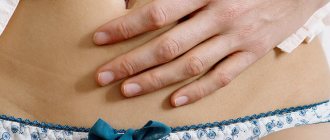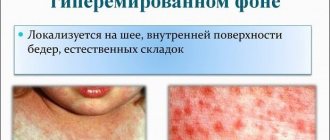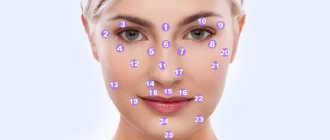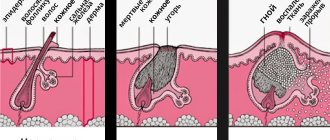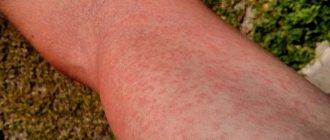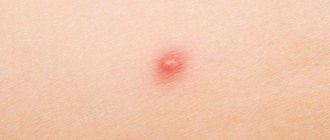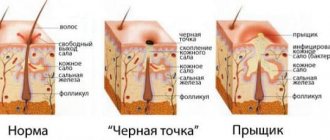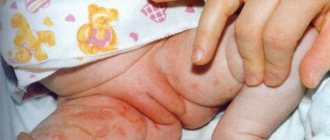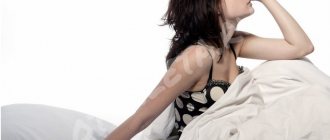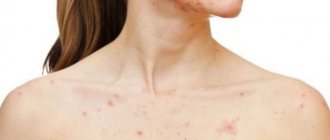Skin diseases
The occurrence of a rash on the chest may be associated with infectious diseases. Without timely diagnosis, it is almost impossible to establish the nature and causes of its occurrence. Acne often forms as a result of secondary infection with syphilis. In this case, a kind of necklace is formed around the neck, which spreads the rays. The rashes are usually mild and do not cause discomfort. Therefore, patients often discover them only after examination by a doctor. This is how secondary infection with syphilis manifests itself.
As the syphilis rash develops, it scars and turns into ulcers.
Tertiary syphilis also appears as a rash under and on the breasts. But the scattering of small hillocks is hard to miss. As they develop, they become scars, large nodules that transform into ulcers and take a long time to heal.
Rashes in adults can signal various childhood infections. They often appear in children.
You may also read:Skin rash and itching
- Red spots and papules may indicate measles. The rash first forms on the face and chest, and then it spreads to the back, legs and stomach. During this period, the temperature may rise, cough, runny nose and eye inflammation may intensify.
- A similar rash occurs with rubella, but it is paler in color. It immediately begins to spread all over the person’s body. At the same time, the cervical and occipital lymph nodes enlarge.
- Chicken rash looks like blisters, which are bright in color and swelling. It can be variegated and accompanied by a rise in temperature.
- Scarlet fever is characterized by a pinpoint rash on the chest that resembles normal redness. Additionally, you need to look at the patient’s tongue, which has a crimson tint.
The rash can also be caused by a tick bite that carries borreliosis or Lyme disease.
- temperature increase;
- headache;
- nausea;
- elevated temperature;
- creeping erythema.
The rash spreads slowly, forming a ring. There is clearing in the middle part, and swelling at the edges. After eliminating the erythema, pigmentation, scarring, complications from the nervous system, blood vessels, heart and joints are observed.
Sometimes the rash under and on the breasts is psoriasis. It has not been studied enough, but doctors can distinguish rashes characteristic of the disease.
At the initial stage of development, small papules have a pink tint. On the surface of the neoplasms there are silvery-white scales. When scraped off, the rash in the chest and back area becomes stearic. Sometimes droplets of blood appear.
Also, prickly heat may appear on the neck, shoulders and chest of an adult. It is formed when the sweat glands are clogged and appears in the form of small bubbles.
A rash in an infant may also indicate heat rash. In childhood, it appears as red papules accompanied by severe itching. It is caused by overheating of the body.
Classification and stages of acne
The method of treating acne is determined depending on its type and stage of the disease. Everyone knows what they look like, but little is known about the classification. If rashes in teenagers are the norm, then hormonal acne in women in adulthood signals a disruption of the endocrine system.
The thrush disappeared in 1 day! New remedy for thrush
Their location can help the dermatologist determine exactly where the disease is hidden:
- blackheads around the lips and on the chin indicate digestive problems;
- – problems of the endocrine system, heart, liver;
- on the forehead - excessive consumption of fatty foods, preservatives or sweets;
- along the hairline – gallbladder disease.
There are three stages of disease severity: mild, moderate and severe. In the mild stage, hormonal acne appears on the face without signs of inflammation. They are scattered evenly. Quantitatively do not exceed ten pieces. At the middle stage - from ten to forty. If there are more than forty of them, inflamed with purulent elements, this is a severe stage.
Types of rashes with characteristic symptoms
It is worth highlighting acne as the most common skin disease. Factors that provoke black spots on the chest and face, which turn into purulent inflammation, include:
- work in enterprises that are harmful to health;
- stressful conditions;
- hormonal imbalances;
- unbalanced diet;
- careless attitude towards taking oral contraceptives;
- selection of cheap, low-quality cosmetics;
- wearing clothes made from artificial materials.
Acne appears after the end of breastfeeding for the same reasons as during pregnancy. A hormonal imbalance affects the functioning of the sweat glands, which causes the skin pores to become clogged with excess sebaceous secretions and become inflamed. In this case, black dots turn into red spots, then into ulcers. Swelling and itching are likely to occur. In addition, scratching and cracking of the skin are possible.
A rash on the chest can be caused by the penetration of a subcutaneous mite
A red rash on the sternum in men and women can be caused by the penetration of a subcutaneous mite into the epidermis. With scabies, pimples begin to itch and hurt if moisture gets on them. Young people are more likely to catch this infectious disease. Also, red spots on the body may appear due to intestinal helminths.
A small rash on the sternum in adults in the form of white pimples may indicate a metabolic disorder. In this case, whitish blisters will appear on the back, chest, neck and skin under the breasts. They are observed in 50 percent of people with diseases such as gastritis, duodenitis and other intestinal pathologies.
Reddish rashes on the mammary glands along with swelling may indicate inflammatory breast cancer. Lung cancer is characterized by spots on the chest that are encircling in nature, but at the same time resemble harmless pigment spots.
Women may develop rashes on their breasts during pregnancy. Patients begin to complain of constant itching and burning.
At the initial stage of development of the pathology, the patient develops red spots. The patient begins to complain of itching and flaking of the skin. A rash under the breasts can appear even after short-term contact with irritating components.
Rash under the breasts
Patients are prohibited from scratching the affected areas if the rash on the chest itches. Such actions lead to the formation of microtraumas. Open wounds contain harmful bacteria that pose a danger to humans. If left untreated, the pathology becomes chronic.
Experts distinguish several degrees of severity of the disease:
- At the initial stage, the patient experiences swelling and slight redness of the chest.
- If left untreated, nodules appear.
- Constant scratching leads to injury to the skin. In inflamed areas, wounds with purulent contents form.
There are several types of allergies:
- The scaly type of pathology is characterized by the presence of a large number of dead cells that vary in size and color.
- An allergy can manifest itself in the form of blistering formations in which liquid is present.
- The purulent form of the pathology is accompanied by the formation of crusts.
- With the nodular type of the disease, plaques appear on the affected areas.
Most often, the rash itself is already a symptom by which one can determine the presence, degree or absence of any disease. But sometimes, when behind a simple rash lies a serious infectious or other kind of disease, the following symptoms may appear: runny nose, fever, eye inflammation, coughing, sneezing, etc.
Other causes of hormonal acne
Other reasons that can lead to hormonal acne include:
- Severe psychological stress, during which androgens are released and sebum production is activated. In addition, the body's immune system may weaken, which will lead to an increase in the affected area.
- Endocrine disorders (genital tumors, pituitary diseases). It is not enough to get rid of acne - you need to visit a specialist, undergo examination, and subsequently treatment.
- Taking steroids. Acne on the back, shoulders or chest can occur due to steroid abuse. To eliminate the problem, it is enough to stop taking the medications that caused the acne.
- Sex (excess or lack). Scientists have been able to prove that sexual relations have a significant impact on hormonal levels. So the connection between the appearance of acne and abuse (or lack of) sex is quite obvious.
Small rash on chest
When diagnosing, the nature of the rash is first determined.
READ ALSO: Seals under the skin in the form of balls, what is it
Point inflammations on the chest and under the breasts can be of a different nature, allowing one to accurately determine the cause of the rash. Therefore, when the first signs are detected, you should pay attention to the appearance and structure of the inflamed area:
- Scales are usually painless formations, representing several layers of cells of dead epidermis. They appear if the natural peeling of the skin is difficult for one reason or another. More often observed in middle-aged and older women.
- Bubbles are an external sign of an allergic reaction. They can cause significant discomfort: itch, become inflamed and increase in size. In advanced cases, blisters can become the initial stage of the development of skin ulcers.
- Crusts - appear on the site of healed wounds and calluses as a consequence of the skin renewal process. In some cases, inflammation or suppuration forms under the crust.
- Papules, or small acne, are the result of serious hormonal imbalances. Once normalized, the patient’s condition goes away on its own without medical assistance. In some cases, specialist intervention is required to eliminate papules.
- Areas of erosion are watery inflammations, sometimes with purulent contents and an unpleasant odor. The result of mutation of the skin in the area of its damage and the appearance of focal inflammation. When opening the film, patients note soreness of the area and its pronounced redness.
- Ulcerative formations - appear as a result of mutation of untreated lesions and inflammation of the skin. They have a certain depth and clear boundaries. When healing occurs, scars are left on the skin.
Very often the rash is accompanied by itching and burning
Depending on the causes of the rash on the sternum in women, its spread may be accompanied by the following unpleasant symptoms:
- severe swelling of the affected area;
- itching and burning that does not occur even during the treatment stage;
- formation of dense nodules under the skin;
- increased dryness of the skin, severe peeling, formation of blisters and ulcers at the site of redness;
- the appearance on the skin of numerous red dots or blisters with watery contents.
When a patient consults a doctor during the initial examination, the following is taken into account:
- patient's age;
- his general health;
- harmful factors that can influence the development of the inflammatory process;
- recent diseases and the results of their treatment.
Results
Hormonal changes are difficult for the body to tolerate and can lead to acne. In such cases, it is important to accurately determine the cause of the problem and only then decide on treatment. It is important to understand that acne is only a consequence, and the body itself must be treated (or allow it to recover on its own).
When hormonal acne appears, it is overwhelmingly associated with puberty. It’s safe to say that almost all people have experienced such an unpleasant symptom as hormonal acne. It happens that it appears in adulthood, for example, due to an imbalance of substances, and hormonal acne in women is not uncommon when they are expecting a child. To understand how acne is treated, it is necessary to consider its types and causes.
Effective treatment methods, especially if the rash itches
Before you start using the drug, regardless of whether it is prepared at home or is a patented medical product, you must first consult a dermatologist.
Reliable home and folk remedies
When the diagnosis does not show the presence of diseases of an infectious nature from itching and acne, traditional medicine can help remarkably:
- Oak bark compress. To prepare it, you need to have 3 tablespoons of oak bark and 200 milliliters of boiling water. The ingredients are mixed and infused in a tightly closed container for 6-8 hours in a warm, dark place. The infusion is then filtered and used for compresses. A piece of gauze should be moistened in the solution and, with a little squeeze, applied to the affected area of the body.
- You should take 4-6 basil leaves and crush them in a mortar with cool boiled water until a homogeneous paste is formed. Apply the resulting mixture to your chest and leave until completely dry. Remains of unabsorbed mixture must be removed with warm water. The procedure is carried out once in the evening when the itching worsens.
- If you have rashes under your breasts, cornstarch can help. It is an effective remedy for reducing itching and burning sensations, but if used incorrectly, the risk of developing fungus increases. In order for starch to help and not harm the patient, the actions should be as follows. You need to wash the affected area with clean water and baby soap. Then dry it thoroughly using a towel and only after it is dry under the breasts, you can sprinkle the rash with corn starch, leaving it to act for 10-15 minutes. After time has passed, rinse off any remaining medication with cool water. The procedure is carried out 2 times a day until complete recovery.
- Masks made from the famous turmeric. That this spice has antibacterial, antifungal and disinfectant properties. And this is exactly what is needed to treat acne on the chest and under the breasts. You will need 1 teaspoon of turmeric and warm milk. By mixing the ingredients, you should get a paste, which immediately after preparation is applied to the area of the rash. The mask exposure time is 30 minutes, then its remnants are washed off with warm water. Treatment is carried out 2 times a day for 7 calendar days.
- Well, a simple way is to use a soda solution. To prepare it you will need 100 milliliters of boiled warm water and 1/2 teaspoon of baking soda. Carefully mix the ingredients and apply the solution to the problem area and let it dry. The procedure must be repeated 2 to 3 times during the day.
If the rash and itching do not subside within 48 hours when using traditional medicine, then you need to contact a dermatologist to identify the true cause of the disease and prescribe medication.
Cosmetological treatment methods
If you are faced with rashes on your chest and back, it may be better for you to contact a cosmetologist and solve the problem professionally. You can resort to special cosmetic procedures.
1. Chemical peels
Cosmetic procedures, depending on the severity and number of inflammatory elements, can include chemical peelings (for example, almond, salicylic, retinoic), ozone therapy, and plasma therapy.
2. Cryotherapy
Cryotherapy (cold treatment) is often used in cosmetology and dermatology in the treatment of various diseases and cosmetic imperfections. Cold has antipyretic, anti-inflammatory, antipruritic and analgesic effects. The method of application can cause different effects of cold on the fabric.
Depending on the pressure and time of application of cold, freezing can cause either destruction, accompanied by tissue death, or only a narrowing of blood vessels with the subsequent expansion of not only active, but also reserve capillaries. During the procedures, cold in the form of liquid nitrogen is used.
3. Phonophoresis
4. Mesotherapy
Mesotherapy is the injection of biologically active substances into the dermis in order to rejuvenate the skin and improve its natural properties. A lack of hyaluronic acid in tissues leads to deterioration in the quality and appearance of the skin, and with the help of mesotherapy a number of problems can be eliminated: early signs of skin aging, dull complexion, dehydrated skin, etc. In our clinic, you can perform mesotherapy in the face and neck area , neckline, etc.
5. Plasma therapy
This is an injection method that involves injecting the patient with his own plasma - the liquid part of the blood. The procedure allows you to launch natural regeneration processes using the body’s internal reserves, without the use of any medications. As a result, tissues are renewed, skin appearance improves and hair growth is restored; There is a general improvement and rejuvenation of the body. The cosmetic effect of the procedure exceeds the effectiveness of many injection and hardware methods. Combines well with other procedures.
Allergic manifestations
A rash on the chest due to allergies resembles an infectious one. Most often, negative changes in the body are characterized by dermatitis. It is caused by contact with an irritant (wool, silk, metal jewelry).
When exposed, the skin begins to redden and swell. At the next stage, bubbles are formed. After they burst, weeping, peeling, and crusts are observed. In this case, the risk of infection of the body increases.
Some people note that after an allergen enters the body, hives form. Most often, its occurrence is influenced by food products and medicines. Red spots and papules form on the skin, occupying large surfaces.
READ ALSO: Rash on the stomach of a child (29 photos): causes with explanations, small and red, after a high fever
Urticaria is a dangerous pathological reaction of the body. After all, it can provoke Quincke's edema and respiratory arrest. If the rash spreads quickly, you should call an ambulance.
An allergic reaction is accompanied by severe itching
Encephalopathy
for patients with encephalopathy Published 11/17/2019 by admin
The chest has a complex structure; its cavity contains vital organs and systems that provide a full life to a person. It is the breast that first alerts a person to the development of pathological processes in the form of inflammation, rashes and other abnormalities. The causes may be allergic reactions, various diseases, as well as physical overexertion and stress. It will not be possible to make a diagnosis on your own, so you should immediately go to the hospital.
Causes of rash under the mammary glands
The appearance of skin rashes caused only by a local reaction to irritation is quite rare. Most cases of inflammation and rash on the sternum are a symptom of a serious disease that requires prompt and thorough diagnosis. Most often, the causes include a weakening of the immune system, which has lost the ability to resist pathogenic external factors.
Causes of the rash include:
- Allergic reactions. First, the skin turns red and spots appear on it, which later take on the structure of blisters with watery contents. After some time, the blisters burst, the skin peels and becomes wet, and then crusts appear on it, causing noticeable itching. It is very important for the patient not to bring the disease to the final stage and to begin treatment in a timely manner. This will avoid extensive inflammation, Quincke's edema and respiratory arrest.
- Pathologies of the skin. More often caused by a malfunction of the sweat glands, less often by serious skin diseases that require qualified treatment.
- Infectious diseases or consequences of diseases of internal organs. Often there are cases of chickenpox, viral pharyngitis, ringworm, and less often - the consequences of syphilis, which could not be completely cured.
- Consequences of stress. The transition of stressful states into depressive states causes the production of corresponding hormones in the body. Their excess causes inflammation on the chest, along the spine, and on the arms. Tangible discomfort and severe itching force the patient to seek medical help. Treatment consists of taking sedative drugs that normalize the body’s condition and calm the nervous system.
- Diseases of internal organs. This could be liver failure, adrenal diseases, dysbacteriosis, internal inflammatory processes, etc.
Watery blisters on the skin: photos, causes, treatment
Water blisters on the body are a sign of infection. The vesicles are filled with a clear or cloudy liquid, inside of which there are pathogens. The blisters may burst, leaving behind wounds that eventually crust over.
Depending on the causes of the pathology, therapy is selected. The main thing is not to try to rip off, squeeze out or open the rash yourself.
Otherwise, this can lead to additional inflammation and suppuration, resulting in scars remaining on the skin after recovery.
How to recognize it in time?
A bubble or vesicle is a round formation on the surface of the skin, filled with clear or cloudy serous fluid with a diameter of up to 5 mm. The edging of the elements may be inflamed. After the contents are poured out, erosion appears - an open red wound. It becomes covered with a crust, which dries out and falls off, leaving no traces.
Such symptoms are characteristic of allergic reactions, eczema, and herpes. Sometimes the blisters turn into pustules, which indicates the bacterial nature of the pathology (for example, with pemphigus). Inflammation affects the deeper layers of the skin, which is why scars remain after the tissue tightens.
Combing the elements significantly slows down healing.
Water bubbles on skin photo
Important! Inguinal athlete's foot is also characterized by the appearance of small bubbles with liquid on the surface of the lesions. But let us remind you that first red spots appear on the body, and then peeling and rashes.
Vesicles do not always signal infection. For example, painful, watery blisters on the hands may be the result of a heat or sunburn. When the sap of the hogweed plant comes into contact with the skin under the influence of ultraviolet radiation, similar traces also appear. The affected skin must be lubricated with wound healing creams.
However, there are other common reasons:
- Hives. Dermatitis is characterized by pink, flat-raised blisters on the skin, reminiscent of nettle burns. The rash appears as a result of an allergic reaction, but can be a symptom of internal disorders in the body. The acute form of the disease disappears after two weeks. Chronic pathology occurs with relapses and periods of remission for many years.
- Contact dermatitis. The reaction occurs after direct skin contact with the allergen. Colorless water blisters on the body itch, accompanied by swelling, redness, pain and burning. Pink spots appear on the body; as the process progresses, the color may turn red-brown. Antihistamines are used to relieve discomfort.
- Chicken pox. The varicella-zoster virus is airborne and causes a watery rash all over the body with fever. The disease mainly occurs in children under 7 years of age. After this, lasting immunity is developed for life, so adults rarely become infected. Initially, pink spots form, transforming into papules, and then into vesicles, surrounded by a red halo. The blisters quickly dry out and become covered with red-brown crusts, which disappear after 2–3 weeks. The fever goes away within 7 days. At this time, bed rest is recommended. Antihistamines are indicated to reduce itching. Heat and increased sweating increase discomfort. To prevent bacterial complications, elements of the rash are treated with brilliant green and Castellani’s solution.
- Shingles. The culprit is the same varicella-zoster virus. It is believed that the pathogen remains in the nerve cells of the body after chickenpox, provoking relapses in the form of rashes on the body on one side. But you can get shingles. The patient's temperature rises, weakness occurs, itching and pain appear in the areas of future lesions. After 3-4 days, pink, swollen spots appear, followed by vesicles with clear liquid. Peripheral lymph nodes swell. The bubbles dry up after a week and disappear. But postherpetic neuralgia (pain) remains for several months. Treatment of the pathology is not required, but it is important to prevent the development of complications. Antiviral drugs, painkillers, antidepressants and corticosteroids are used for this.
- Eczema. Watery blisters on the skin itch and appear due to poor functioning of the gastrointestinal tract, liver and kidneys, mechanical stress, immune deficiency, infection or allergy, and genetic predisposition. True eczema is characterized by small vesicles that quickly turn into erosions and become covered with crusts. The process begins with symmetrical damage to the face, hands, and then spreads throughout the body. Severe itching disrupts quality of life and sleep. The doctor determines the course of treatment individually depending on the form of the disease. Patients are not recommended to wear synthetic clothing or eat allergenic foods.
- Simple herpes. The infection is characterized by blisters on the mucous membranes of the nose and lips. They itch, and after the contents spill out, they turn into painful ulcers. Within two weeks, the rash dries up and disappears without a trace. Antiviral ointments are indicated to prevent the spread of infection.
- Epidermolysis bullosa. Blisters and erosions form on the skin and mucous membranes due to the increased sensitivity of epithelial tissues to mechanical stress. Blisters appear on the hands, feet, and sometimes cover the entire body. Exacerbation of hereditary disease occurs in the summer. There are no radical ways to treat the pathology, but symptomatic remedies are used. The main goals of therapy are to prevent the growth and bacterial infection of lesions.
- Pemphigus. An autoimmune disease affects the skin and mucous membranes. The prognosis for recovery is unfavorable, since even timely therapy does not exclude death.
If watery blisters on the body caused by an allergy are not touched, then after a few days they begin to dry out on their own .
But when the negative impact of the irritant is not eliminated, the rash quickly spreads to healthy areas. It is important to identify which foods, medications or external factors provoke the reaction.
Viral pathologies require symptomatic treatment. Bacterial infections require antibiotic therapy.
Loading…
When medical attention is needed
The asymptomatic course of the rash is not a reason to refuse diagnosis and medical care. In some cases, consultation with a doctor is urgently necessary. The appearance of an itchy rash can be a consequence of the following diseases:
- rubella;
- measles;
- Lyme disease after a tick bite;
- scarlet fever.
The treatment process includes the use of topical medications to eliminate the rash. Otherwise, it can cause complications: scars, darkening of the skin, pigmentation, disturbances in the functioning of the nervous and cardiovascular systems.
The following cases also require immediate medical attention:
- painful rash;
- intensive distribution throughout the body;
- lack of visible effects with local treatment;
- degeneration of inflammation into numerous papules, ulcers or blisters.
What tests should I take?
Your attending physician will prescribe treatment for you, but before that he will ask you to undergo tests. You should not take tests for everything yourself. I'll tell you about several tests that you may be asked to take.
- Rashes on the chest can occur due to disruption of the pancreas (due to poor nutrition or endocrine diseases, in particular diabetes). Therefore, it is worth contacting a gastroenterologist and taking a blood test for sugar and biochemistry, as well as doing an ultrasound.
- Rashes on the shoulders often occur due to intestinal dysfunction caused by frequent stress. It is worth contacting a gastroenterologist, as well as a psychologist or psychotherapist and taking a course of sedatives.
- Acne above the eyebrows, inflamed pimples on the tip of the nose and wen on the eyelids are a sign of disruptions in the cardiovascular system (development of arrhythmia, hypertension, etc.). You need to visit a cardiologist, do an ultrasound of the blood vessels and heart, and a cardiogram.
- Rashes on the neck are a sign of hormonal imbalances, in particular thyroid dysfunction. You need to visit an endocrinologist and do an ultrasound of the thyroid gland.
- Rashes on the wings of the nose - it’s time to do fluorography and ultrasound of the respiratory tract (this is how developing diseases of the lungs and bronchi can manifest themselves).
- Inflamed purulent rashes or red pimples on the chin indicate malfunctions of the genitourinary system, the presence of sexually transmitted infections, as well as an imbalance of sex hormones. It is worth contacting a gynecologist or urologist.
- Inflamed pimples on the forehead, nose, cheekbones and cheeks are a sign of digestive and intestinal problems, most likely caused by poor diet (excess spicy food, fast food, lack of diet). With this problem, you should contact a gastroenterologist and nutritionist.
- Acne or red spots on the hairline and temples are a reason to visit a gastroenterologist and check the functioning of the liver and gallbladder (using ultrasound, MRI or CT).
- Pimples on the lower back - you need to see a urologist and have your bladder and kidneys checked. Perhaps the reason is the development of urolithiasis.
- Inflamed red pimples or acne in the area of the shoulder blades - you should visit a gastroenterologist and have your liver checked (take liver tests, do an ultrasound).
- Painful rashes on the buttocks and thighs may be the result of poor nutrition, intoxication, or intestinal disorders. First of all, you need to contact a gastroenterologist, take a general blood test, do an ultrasound of the gastrointestinal tract, and others - as indicated.
- Inflamed red pimples or acne in the area of the shoulder blades - you should visit a gastroenterologist and have your liver checked (take liver tests, do an ultrasound).
Emotional stress
When a person experiences negative emotions, the level of certain hormones in the body increases. Due to this, physiological and metabolic processes occur with disturbances.
As a result of a malfunction, a person may develop a rash on the sternum, arms and along the spine. The rash causes severe discomfort and is accompanied by unbearable itching.
Such formations on the skin can be eliminated only after normalization of the nervous system with the use of sedatives and psychological consultations.
Hormonal acne in men
In adolescence, boys suffer from hormonal acne no less than girls. Now we need to figure out why adult men get acne. When a member of the stronger sex takes steroids, his testosterone levels increase. This can be regarded as a hormonal imbalance, as a result of which men develop hormonal acne. If a person wants to get rid of acne, it is necessary to stop taking anabolic steroids.
There are other causes of acne in adult men:
- stress;
- folliculitis - the hair follicle becomes inflamed after shaving (infection gets into small cuts and leads to a negative process);
- poor nutrition;
- lack of proper hygiene;
- prolonged exposure to the sun - under the influence of ultraviolet radiation, the secretion of sebum increases, creating favorable conditions for bacteria.
Diagnosis and treatment of breast skin pathologies
The content of complex therapy for rashes in the chest area depends on the causes of their appearance. More often these are antihistamines and aseptic drugs that dry and disinfect the skin. Their use simultaneously with the treatment of the underlying disease allows you to eliminate the symptom and associated discomfort. The use of the following folk remedies will help speed up the process of healing and restoration of the skin:
- Cold compresses with ice cubes. Relieves swelling and itching, reduces the severity of the inflammatory process on the skin. The compress is kept for 6-8 minutes. You can use a cold shower instead.
- Coconut oil. Tones the skin, eliminates the consequences of its contact with clothing, and helps fight infectious diseases of the skin.
- Tea tree oil has pronounced antifungal properties. Use in equal proportions with olive oil. The mixture is rubbed into the skin after a shower or before bed so that it is completely absorbed into the affected area.
- Aloe vera - has antibacterial properties, reduces itching and burning, softens the affected area of the skin. There are no serious contraindications for use.
The treatment regimen is determined by the doctor after examining and examining the patient, studying the medical history and identifying the cause of the pathology. For this purpose, laboratory diagnostics and instrumental studies are carried out.
Laboratory diagnostics include general and biochemical tests of blood and urine, analysis of bacterial culture and scraping of the pathological contents of rashes and other tests. This allows you to determine the cause of the rash and choose the most effective treatment method.
Depending on the type and nature of the rash, treatment is carried out by specialized specialists - an infectious disease specialist, dermatologist, mammologist, therapist or oncologist.
With all pathological changes in the skin of the breast, you can contact qualified multidisciplinary specialists. The clinic’s patients have access to a modern diagnostic laboratory, which performs a large number of laboratory tests, as well as modern diagnostic equipment of an expert level, which allows us to provide medical services at the level of world standards of treatment.
The connection between hormones and acne
What hormones affect acne? The following can be distinguished from them:
- dehydrotestosterone;
- testosterone;
- dehydroepiandrosterone;
- insulin-like growth factor.
These hormones can fluctuate in one direction or another in the following cases:
- during puberty;
- during pregnancy and lactation;
- during the menstrual cycle;
- during menopause;
- when taking contraceptives and other medications.
To establish the cause and treat hormonal acne, the following studies must be carried out:
- general blood analysis;
- infectious agent test;
- antibacterial sensitivity test;
- hormone test - this analysis will show what effect hormones have on the body and whether rashes could appear due to their imbalance.
How to get rid of pimples?
Who to contact?
Do not neglect a timely visit to a specialist - if you notice a rash on your chest, you should consult a dermatologist as soon as possible. It is he who will be able to determine the cause of the rash.
If going to a dermatologist for some reason is difficult, you need to visit at least a cosmetologist (this will be a little easier, since there are now cosmetology offices in every region)
READ ALSO: Rash on the legs of a child (31 photos): causes of a small red rash with explanations, without fever on the cheeks of an infant
In this case, it is worth paying special attention to the fact that the specialist must have a medical education. This is a very important point, because many practicing cosmetologists only take courses and can only help with local elimination of the problem, which is not a complete solution.
You need to find the cause and deal with it, then the manifestations will go away by themselves.
An experienced specialist will be able to eliminate not only the external manifestations of the rash, but will also prescribe appropriate medications to treat possible internal ailments. He will also discuss the diet that will need to be followed for further recovery.
Consult a doctor to identify the problem and eliminate the rash faster
Simple remedies for acne and comedones
If for some reason a visit to a dermatologist or cosmetologist is impossible, you can use traditional medicine that will help eliminate rashes:
- Lemon juice helps with various types of acne. Since citrus has antibacterial properties, it can be used to make a tonic. The recipe is as follows: lemon juice and clean water are taken in equal proportions, a few drops of tea tree oil are added to them, all this is poured into a spray bottle. After spraying, you need to wait for the liquid to dry, then rinse off. The procedure should be carried out several times a day until the rash completely disappears.
- Another tonic, the preparation of which uses sea salt, also has a drying effect. The principle is the same as in the first recipe: we make a not very concentrated solution of sea salt and spray it on the skin several times a day.
- Tar soap also dries pimples well, which significantly speeds up their healing process. It can be used daily. Just remember that such a product should not be used for a long time: there may be a risk of dehydration, which will cause peeling of the skin.
- If you have severe rashes, you should also remember to regularly iron your bed linen.
Treatment for hormonal acne
How to deal with an unpleasant phenomenon? Elimination of rashes should be carried out in a complex manner. How to treat acne due to hormonal imbalance should be decided by an endocrinologist or gynecologist. To get rid of unpleasant formations, you need to adhere to the following direction of therapy:
- take prescribed medications;
- restore the outer layer of skin;
- use traditional medicine;
- use ointments and masks;
- follow a diet.
How to get rid of hormonal acne? Correcting hormonal imbalance in the body will not be possible quickly, since the treatment is long-term - more than a month. Medications must be taken in courses. Doctors often prescribe birth control pills; they regulate hormone production and restore the menstrual cycle. Dermatologists may recommend scrubs and ointments based on salicylic acid and zinc to cleanse the deeper layers of the skin.
Folk remedies also work very well in this case. It is not recommended to get rid of acne on your own; it is better to clean your skin in beauty salons to prevent complications. Now cosmetologists have products in their arsenal that can carry out very deep peeling, after which not a trace of acne will remain. As for nutrition, spicy, salty and sweet foods should be excluded. An excess of these products causes a disturbance in fat metabolism, which is the cause of clogged pores.
Acne due to hormones requires treatment with the following pharmaceuticals:
- antibiotics - Minocycline, Doxycycline, Clindamycin;
- contraceptives - Yarina, Zhanine;
- for skin regeneration - Metronizadol;
- antibacterial - Trichopolum;
- hormonal cream - Curiosin.
All these drugs must be prescribed by a doctor, who also prescribes the dosage and duration of the course. Serious complications may occur if you take these medications on your own.
Diagnosis and treatment of breast skin pathologies
The skin reflects any changes in the body. Therefore, when problems occur, a person notices that a rash has appeared in the chest area. If the acne is large and painful, and is also localized on the back, then we can assume:
- kidney pathologies;
- liver problems;
- dysbacteriosis;
- dysfunction of the gastrointestinal tract;
- hormonal imbalances;
- gynecological diseases.
An exacerbation is often triggered by a change in diet to include large amounts of carbohydrates and a decrease in the level of healthy fats and amino acids. These substances disrupt the functioning of the sebaceous glands.
Drug therapy
If allergies occur on the skin of the chest, specialists prescribe the following antihistamines:
- "Tavegil".
- Zyrtec.
- "Suprastin".
- "Fenistil".
- "Claritin."
- "Diazolin".
Antihistamines are prescribed by a specialist only after a complete examination has been carried out. Please note that the specialist you contact for help must be experienced and preferably proven.
Prevention recommendations
You can avoid the appearance of pimples or inflamed areas on the skin if you adhere to the following recommendations:
- use cosmetics from trusted manufacturers;
- wear clothes made from natural materials;
- wash wardrobe items as they become dirty, avoiding wearing them for a long time;
- monitor your health, treat emerging diseases in a timely manner and complete the treatment course;
- eliminate stressful situations, normalize sleep;
- review your diet, giving preference to foods high in protein and Omega-3 polyunsaturated acids, and abandoning foods high in carbohydrates.
When treating a rash on the chest, it is important to follow the recommendations of your doctor and complete the course. In this case, it will be possible to cope with the cause of inflammation and prevent its recurrence.
Folliculitis
Folliculitis is inflammation of the hair follicles. In most cases, this inflammation is caused by bacterial infections. It can occur in areas where there is thicker hair and the chest is one of the most commonly affected areas. In addition to itching in the chest, there is also burning, pain and tenderness of the skin with tiny bumps or open blisters.
Although it can more often occur on the scalp, chest, armpits and groin, folliculitis can occur anywhere on the body except the palms and soles of the feet. It can be superficial (limited to the outermost layers of the skin) or deep. Staphylococcus aureus is the bacterium that is the most common cause of this condition, but viruses and even fungi can be responsible for this condition.
Ignoring personal hygiene rules
Between and in the area of the breasts there are a large number of sweat and sebaceous glands. They are necessary for the production of sebum and sweat.
Sweating is considered a natural process for every person. But with its intensity, moisture accumulation is observed. Due to this, a rash forms under the breasts.
Rashes can be caused by:
- violation of the body's thermoregulation;
- long-term physical activity;
- wearing clothes made of synthetic fabrics or uncomfortable tight things;
- overheating;
- obesity and obesity;
- increased temperature due to various pathologies.
Women can also suffer from an incorrectly chosen bra, which puts pressure on the glandular area.
You can prevent clogging of the sebaceous glands by following good hygiene rules.
A rash on the chest and back is formed when the sebaceous glands are clogged. This occurs due to the prolonged presence of dead cells, fat and sweat secretions on the surface of the skin. These phenomena are due to:
- wearing dirty clothes for a long time;
- lack of hygiene;
- applying low-quality cosmetics to the skin.
Such rashes themselves can be easily eliminated with skin care. But if you ignore them, serious dermatological pathologies develop.
Subtypes of hormonal acne
Based on how acne looks on the face, they are divided into conventional subtypes:
- A comedon is a white or black formation. At its core, it is a sebaceous plug that closes the pore and provokes an inflammatory process in it. Comedones can be closed or open. The latter are characterized by the fact that the plug is located on top of the pore. The notorious blackheads are the same comedones, it’s just that the sebum has oxidized in the air and turned black. Closed pimples are localized in the deep layers of the skin, they are also called wen. Removing them is difficult.
- Papule - this type occurs when an infection is attached to a pimple. The skin turns red and may feel painful when pressed.
- Pustules are papules that have not been properly cared for. At its core, it is a purulent acne.
- Nodular cystic formations are complications of pustules. They look like a group of pimples that have fistulous ducts between them.
- Lightning acne. This is the most severe form of rash, which affects large areas of the skin, causing fever, pain and other symptoms. In this case, timely assistance from dermatologists is indicated.
